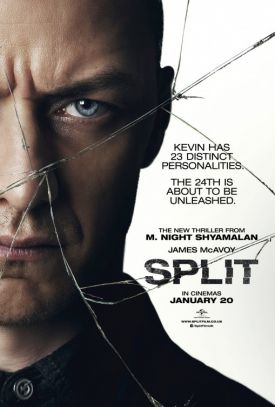Split, the recently released horror movie directed by M. Night Shyamalan, adds to a long list of media depictions—Three Faces of Eve, Psycho, Dressed to Kill, United States of Tara, Shutter Island, and many others—where plots hinge on dramatic portrayals of “multiple personalities” that bear little resemblance to reality. Though meant to entertain, these portrayals increase stigma for individuals living with a serious mental health condition, dissociative identity disorder (DID). And with Split being the top movie at the box offices for three weeks running, this inaccurate portrayal and accompanying stigma is becoming increasingly widespread.
Whether or not you plan to see the movie, you should know that lurid fictional stories about DID harm those who actually suffer from the disorder. Split adds to the burden of stigma for people with DID, many of whom face fear, disbelief, and derision when others, influenced by media inaccuracies, learn of their condition.
Unfortunately, like much of the public, many mental health professionals also learn what they know about DID from popular media. As movies like Split depict a cartoonish portrayal of DID, misunderstandings about the disorder become more ingrained. Many professionals either “don’t believe” it exists or have significant misconceptions about DID. As a result, many people suffering from DID do not receive accurate diagnosis and the treatment they need.
As the founder and medical director of The Trauma Disorders Program at Sheppard Pratt Health System, which treats patients with complex trauma including those with DID, I join many professional organizations, providers, and patients in strongly criticizing this movie’s inaccurate, comic book portrayal. Although Split would lead you to believe otherwise, people with DID are not violent predators made up of dramatically different, separate “people.” Experienced clinicians do not treat individuals with DID as a collection of separate people, as portrayed in the movie, but as unintegrated aspects of a single person. Symptoms of DID almost always are covert and subtle, embedded in symptoms that are ascribed to other disorders. A clinician expecting dramatically different, spontaneously appearing personalities, like in popular media portrayals, will usually fail to diagnose and correctly treat DID.
 In Split, the main character, Kevin Wendell Crumb, was a victim of extreme early childhood abuse. This is the only aspect of DID the movie gets right. Cross-cultural studies find that almost all children and adults with DID report severe childhood trauma, primarily physical, sexual, and emotional abuse beginning before age six.
In Split, the main character, Kevin Wendell Crumb, was a victim of extreme early childhood abuse. This is the only aspect of DID the movie gets right. Cross-cultural studies find that almost all children and adults with DID report severe childhood trauma, primarily physical, sexual, and emotional abuse beginning before age six.
In reality, DID is a childhood adaptation to unpredictable, dangerous, abusive situations. When genetically predisposed individuals are repeatedly subjected to traumatic situations in early life, they do not develop a normal, whole sense of self. Rather, they develop multiple, semi-independent senses of self, often in conflict with one another. DID is not a “shattered mirror” where the unified personality is “broken apart” by trauma. DID is more like a childhood-onset, psychological jig-saw puzzle that has never been put together.
One can think of DID as a “secret survival system.” Data from studies at Sheppard Pratt and Towson University show that early-life dissociation is a form of resilience that protects the normal development of intellectual abilities, creativity, insight, hope, and the capacity to form relationships with others. Because capacity for insight, cognition, and the ability to delay action are preserved in DID, generally we hold “the whole human being” responsible for all behaviors, including criminal conduct.
Split, like many other fictional media representations, depicts the individual with DID as a sadistic serial killer. However, studies show that only a small minority of DID individuals are violent towards others. DID individuals are actually more likely than others to be targeted by violence, especially rape and intimate partner violence.
Society, especially medical professionals, should recognize DID as the serious mental illness that it is. Studies show that patients with DID may spend six to twelve years in the mental health system before receiving the correct diagnosis. Misdiagnosis creates substantial costs to the individual, the health system, and society by preventing individuals with DID from receiving treatment that works and can be lifesaving.
Before watching this movie, please recognize that M. Night Shyamalan’s goal is not to educate, but to entertain—and to make a lot of money. Rather than showing realistic characters that truly reflect the complexity of living with DID, he fell back on the same harmful stereotypes and clichés used so many times before. Defeating mental health stigma might not be a priority for M. Night Shyamalan or others in Hollywood. However, as a society, and especially as health care providers, we have a responsibility to help raise awareness, provide accurate information, and help people in need access lifesaving treatment.
Dr. Richard J. Loewenstein is a senior psychiatrist and the founder and medical director of The Trauma Disorders Program at Sheppard Pratt. Dr. Loewenstein lectures frequently on dissociation and trauma to regional, national, and international groups. He is the author of many papers and book chapters on sleep disorders, consultation-liaison psychiatry, dissociation, dissociative disorders, and trauma disorders. He has also received numerous awards for his contributions to clinical studies of trauma and dissociation. Dr. Loewenstein is a clinical professor in the Department of Psychiatry at the University of Maryland School of Medicine, Baltimore, MD.